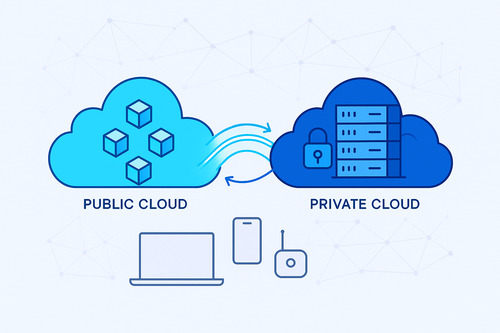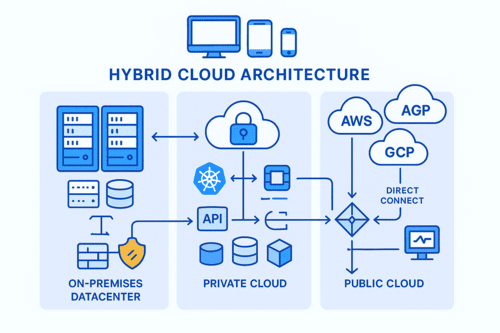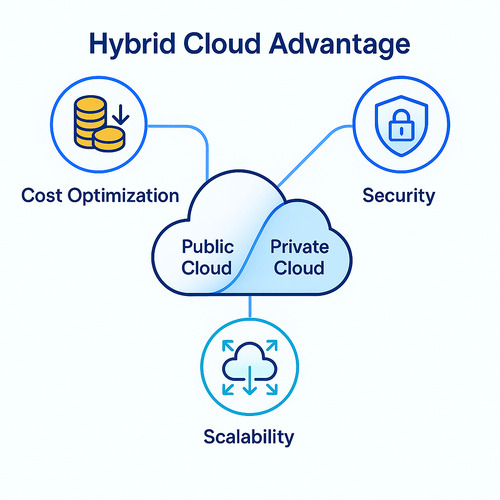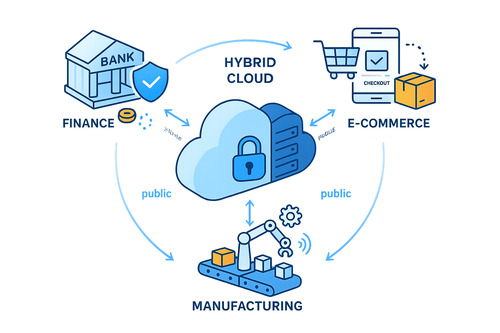Understanding Hybrid Cloud Architecture: Benefits and Examples of Hybrid Cloud Architecture for Enterprises
Blog / Understanding Hybrid Cloud Architecture: Benefits and Examples of Hybrid Cloud Architecture for Enterprises

With the accelerated digital transformation around the world, enterprises are facing increasingly diverse and complex IT infrastructure requirements. Hybrid Cloud is a new solution that combines public and private clouds to enhance the flexibility and security of digital utilization. The following is an in-depth analysis of the Hybrid Cloud architecture and advantages, and illustrates the application of Hybrid Cloud with examples, explaining how Hybrid Cloud can help enterprises to enter into a higher-end digital transformation and optimize the allocation of enterprise resources.
Understanding the Fundamentals of Hybrid Cloud: Public Cloud vs. Private Cloud

Private Cloud
A private cloud is a cloud environment designed exclusively for a single enterprise or organization. All resources are reserved for internal use and are not shared with external users. The infrastructure of a private cloud can be deployed within the enterprise’s own data center or built and hosted by a third party specifically for that enterprise. Private clouds emphasize high data security and privacy while offering full autonomy and control. Enterprises can configure resources, manage permissions, and customize systems according to their specific needs, making them particularly suitable for industries with stringent requirements for data protection, compliance, and service stability. However, the construction and maintenance costs of private clouds are relatively high, requiring IT departments to shoulder greater management and maintenance responsibilities.
Public Cloud
Public cloud refers to a cloud model where third-party providers deliver various cloud resources and services to all enterprises or individual users via the internet. Public cloud resources are extremely abundant, including virtual machines (VMs), computing power, data storage, networking, and diverse applications. All users access these resources in real-time over the internet and pay based on actual usage. The infrastructure and hardware of public clouds are built, managed, and maintained by the cloud service provider. Users do not need to invest in or maintain IT hardware themselves, significantly reducing initial costs and operational burdens. As public clouds operate on a multi-tenant architecture where resources are shared among multiple users, they are well-suited for businesses requiring flexible scalability, cost sensitivity, or rapid deployment.
What is a hybrid cloud architecture?

A hybrid cloud architecture is an IT environment that strategically integrates and coordinates an enterprise’s private cloud with the services and resources of one or more public clouds. Under this architecture, enterprises distribute applications, workloads, and data across the most suitable cloud environments based on their specific characteristics. Simultaneously, they leverage the elasticity and scalability of public clouds to handle sudden traffic spikes or large-scale computational demands. This architecture enables enterprises to flexibly allocate resources according to varying business demands, achieving optimal cost-effectiveness and operational efficiency.
The core of hybrid cloud architecture lies in “seamless integration”—internal data centers (private clouds) and external cloud services (public clouds) must collaborate through secure, efficient connectivity to ensure the smooth operation of data and applications.
Hybrid Cloud Advantages

As enterprise IT environments grow increasingly complex, hybrid cloud solutions have become the mainstream choice. Compared to relying solely on private or public clouds, adopting a hybrid cloud approach offers the following advantages:
1. One-Stop Multi-Cloud Connectivity Service
The foundation of hybrid cloud architecture lies in securely and efficiently connecting internal enterprise data centers (private clouds) with external public cloud resources. Hybrid clouds typically offer multiple connection methods, such as private lines or VPNs, enabling enterprises to exchange data and collaborate across different cloud platforms. They also support flexible connections between multi-cloud environments and cloud-to-cloud scenarios. This one-stop connectivity significantly simplifies resource allocation and management, enhancing IT operational efficiency.
2. Cost Savings Through Flexible Hybrid Cloud Deployment Models
Hybrid clouds enable enterprises to deploy IT resources flexibly based on actual needs. For instance, companies can deploy sensitive data and critical applications on private clouds to ensure security and compliance, while migrating workloads with high computational demands or seasonal traffic to public clouds to benefit from elastic scalability and cost optimization. This flexible hybrid cloud model enables businesses to dynamically adjust resources based on real operational needs, avoiding waste from overprovisioning due to inaccurate forecasts. Long-term, this approach helps enterprises continuously enhance cost efficiency.
3. Professional Management and Security Assurance
Hybrid cloud security ranks among enterprises’ top concerns. Hybrid cloud solutions typically integrate multi-layered security technologies, including traffic encryption, access control, threat detection, and automated vulnerability assessment, ensuring secure data and application transmission and storage across diverse cloud environments. Additionally, unified management platforms provide cross-cloud resource monitoring, permission management, and compliance auditing, reducing management complexity and boosting IT team efficiency.
4. High-Performance Computing and Resource Flexibility
For enterprises requiring high-performance computing (such as AI, machine learning, or big data analytics), hybrid clouds offer flexible access to public cloud resources like GPUs. This enables on-demand scaling of computational power without the need to build expensive hardware infrastructure. This approach not only boosts computational efficiency but also optimizes budget allocation for businesses.
Practical Examples of Enterprise Hybrid Cloud Architecture

Here are some examples of how companies across different industries leverage hybrid cloud to maximize its benefits:
Financial Services: Expanding Cloud Data Centers
Financial institutions can leverage hybrid cloud architectures to deploy core transaction systems on private clouds, ensuring data security and compliance. Simultaneously, customer behavior analysis and big data processing workloads can be placed on public clouds, utilizing their powerful computing capabilities to rapidly complete analyses and enhance decision-making efficiency.
E-commerce and Retail: Flexible Seasonal Traffic Management
During promotion and peak seasons, e-commerce companies can rapidly scale public cloud resources via hybrid cloud to handle traffic surges and prevent website crashes. Routine operations primarily run on private clouds during off-peak periods, optimizing cost efficiency.
Manufacturing: Secure Data Backup Solutions
Manufacturing enterprises, for instance, leverage hybrid cloud architectures to back up core production system data to public clouds as secure backup solutions. This ensures rapid restoration of production system operations during local data center (private cloud) failures, further safeguarding production system stability.
Higher Education Institutions: Research and Teaching Platform Support
Although higher education institutions are not enterprises, they can still take advantage of hybrid cloud architecture, such as deploying sensitive student data and academic systems in the private cloud to ensure data privacy. Universities can also deploy their research projects, simulation experiments or online learning platforms that require large amounts of computing resources in the public cloud, utilizing its flexible and scalable computing power to meet peak teaching and research needs, and paying for actual usage to effectively control costs.
Construction Industry: Project Collaboration and Data Management
Construction companies can store sensitive information such as core design drawing files, project progress and contract data in the private cloud through hybrid cloud to ensure project data security. At the same time, engineering firms can deploy BIM (Building Information Modeling) model sharing, on-site image streaming, and supply chain management applications that require external collaboration in the public cloud, allowing partners to access and collaborate anytime, anywhere, improving project execution efficiency and flexibly expanding storage space to cope with the growing volume of data storage.
Healthcare Industry: Patient Privacy and Data Analytics
Healthcare institutions can leverage hybrid cloud architectures to store sensitive data like electronic health records within strictly monitored private cloud environments, ensuring compliance with healthcare regulations. Hospitals or medical schools requiring computational resources for genomics analysis, drug development simulations, or AI-assisted diagnostics deploy resource-intensive software on public clouds to accelerate research and therapeutic development. Non-sensitive clinical data is processed using public cloud analytics tools.
Choose OneAsia Hybrid Cloud Services to Drive Enterprise Digital Transformation
After understanding the numerous advantages, key architectures, and practical application examples of enterprise hybrid clouds, you can further explore the hybrid cloud solutions offered by OneAsia. We offer a combination of secure and reliable data center infrastructure, flexible multi-cloud connectivity, high-performance GPU computing resources, and professional cloud management services and cloud hosting services that can effectively meet the diverse needs of enterprises in Hong Kong and the Asia-Pacific region in the journey of digital transformation. Whether your organization seeks to enhance cloud connectivity efficiency, strengthen data security, or requires high-performance computing support, OneAsia delivers tailored hybrid cloud service solutions. Contact OneAsia today to experience our one-stop hybrid cloud solutions.


